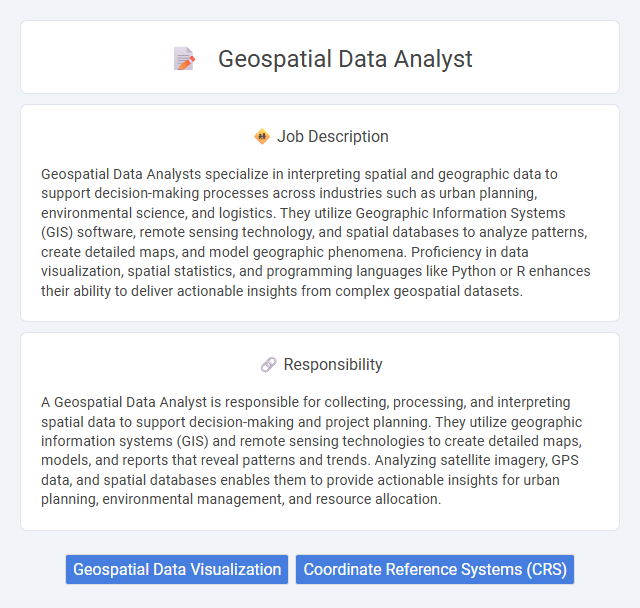
Geospatial Data Analysts specialize in interpreting spatial and geographic data to support decision-making processes across industries such as urban planning, environmental science, and logistics. They utilize Geographic Information Systems (GIS) software, remote sensing technology, and spatial databases to analyze patterns, create detailed maps, and model geographic phenomena. Proficiency in data visualization, spatial statistics, and programming languages like Python or R enhances their ability to deliver actionable insights from complex geospatial datasets.
Individuals with strong analytical skills and a keen interest in mapping and spatial data are likely to be well-suited for a Geospatial Data Analyst role. Those comfortable working with GIS software and interpreting complex datasets may find this job aligns with their abilities and preferences. Conversely, people who struggle with technical tools or prefer less detail-oriented tasks might find the role challenging or less suitable.
Qualification
A Geospatial Data Analyst typically requires proficiency in Geographic Information Systems (GIS) software such as ArcGIS and QGIS, alongside strong skills in spatial data visualization and analysis. Expertise in programming languages like Python or R for data manipulation, as well as knowledge of remote sensing and geospatial databases, is essential. A bachelor's degree in geography, environmental science, computer science, or related fields often serves as a minimum qualification, with advanced certifications enhancing job prospects.
Responsibility
A Geospatial Data Analyst is responsible for collecting, processing, and interpreting spatial data to support decision-making and project planning. They utilize geographic information systems (GIS) and remote sensing technologies to create detailed maps, models, and reports that reveal patterns and trends. Analyzing satellite imagery, GPS data, and spatial databases enables them to provide actionable insights for urban planning, environmental management, and resource allocation.
Benefit
Geospatial Data Analyst roles likely offer significant benefits including enhanced decision-making capabilities through detailed spatial data interpretation. There is a strong probability of career growth due to the increasing reliance on geographic information systems (GIS) across various industries. Employees may also experience improved problem-solving efficiency and access to advanced analytical tools that support data-driven strategies.
Challenge
The role of a Geospatial Data Analyst likely involves navigating the challenge of handling large, complex datasets that require meticulous analysis to extract meaningful insights. There may be frequent difficulties in integrating diverse data sources and ensuring data accuracy, which can impact decision-making processes. Adapting to rapidly evolving geospatial technologies and software also seems to be a common obstacle in this field.
Career Advancement
Geospatial Data Analysts leverage spatial data and advanced GIS technologies to extract actionable insights, driving informed decision-making across industries such as urban planning, environmental science, and logistics. Mastery of tools like ArcGIS, QGIS, and programming languages such as Python and R positions professionals for advancement into senior analyst, GIS manager, or data science roles. Continuous skill development in machine learning, remote sensing, and big data analytics significantly enhances career growth opportunities within the evolving geospatial sector.
Key Terms
Geospatial Data Visualization
Geospatial Data Analysts specialize in transforming complex geospatial datasets into intuitive visual formats using tools like ArcGIS, QGIS, and Tableau to support decision-making in urban planning, environmental monitoring, and transportation. They apply spatial analysis techniques to map trends, patterns, and relationships, enhancing geospatial data interpretation for stakeholders. Proficiency in GIS software, remote sensing data, and programming languages such as Python or R is essential for creating dynamic, interactive visualizations that improve spatial data communication.
Coordinate Reference Systems (CRS)
A Geospatial Data Analyst specializes in managing and interpreting spatial data using advanced Coordinate Reference Systems (CRS) to ensure accurate geolocation and spatial analysis. Expertise in transforming and projecting data across various CRSs enables seamless integration of diverse datasets, supporting precise mapping and decision-making processes. Proficiency in tools like ArcGIS and QGIS enhances the ability to analyze spatial relationships and maintain data integrity in complex geospatial projects.
 kuljobs.com
kuljobs.com